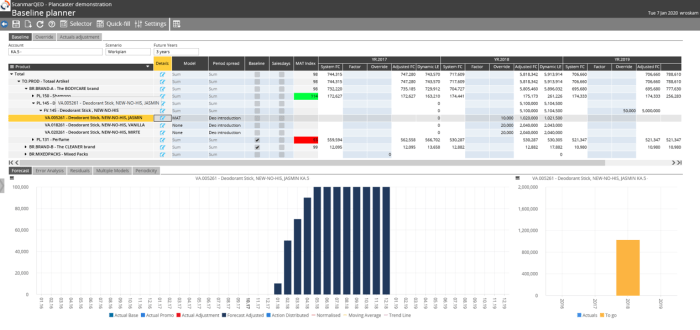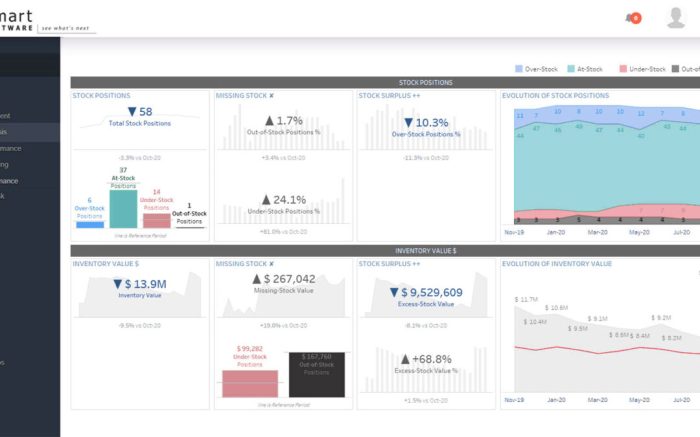Sales and operations planning software represents a significant advancement in business management, offering a powerful suite of tools to integrate sales forecasts with operational capabilities. This integration allows companies to optimize resource allocation, improve production scheduling, and ultimately enhance profitability by aligning supply with demand more effectively. The software facilitates better decision-making through data-driven insights, enabling proactive adjustments to changing market conditions and unforeseen disruptions.
Effective sales and operations planning (S&OP) is crucial for businesses of all sizes, from small startups navigating rapid growth to large enterprises managing complex global supply chains. By leveraging sophisticated algorithms and data visualization, this software helps businesses anticipate potential bottlenecks, reduce inventory costs, and improve customer satisfaction through timely order fulfillment. The result is a more efficient, responsive, and ultimately more successful organization.
Effective sales and operations planning (S&OP) is crucial for businesses of all sizes striving for sustainable growth and profitability. It bridges the gap between sales forecasts and operational capabilities, ensuring alignment across departments and optimized resource allocation. This comprehensive guide explores the vital role of S&OP software in streamlining this process, enhancing decision-making, and driving business success. We’ll delve into the key features, benefits, selection process, and frequently asked questions to help you understand how S&OP software can transform your organization.
Understanding Sales and Operations Planning (S&OP): Sales And Operations Planning Software
S&OP is a strategic process that integrates sales forecasts, production planning, inventory management, and supply chain operations. It involves cross-functional collaboration to develop a unified plan that balances supply and demand, optimizes resource utilization, and minimizes costs. A well-executed S&OP process improves forecast accuracy, reduces inventory holding costs, improves customer service levels, and enhances overall profitability.

Source: scanmarqed.com
Key Components of an Effective S&OP Process:
- Demand Planning: Accurately forecasting future demand based on historical data, market trends, and sales inputs.
- Supply Planning: Determining the necessary resources (materials, labor, capacity) to meet forecasted demand.
- Inventory Management: Optimizing inventory levels to balance the costs of holding inventory with the risk of stockouts.
- Sales & Operations Execution: Implementing and monitoring the S&OP plan, making adjustments as needed.
- Performance Measurement: Tracking key performance indicators (KPIs) to assess the effectiveness of the S&OP process and identify areas for improvement.
The Role of S&OP Software
While S&OP can be implemented manually, using dedicated software significantly enhances efficiency and accuracy. S&OP software automates many of the time-consuming tasks involved in the process, allowing planners to focus on strategic decision-making. It provides a centralized platform for data integration, collaboration, and scenario planning.
Key Features of S&OP Software:
- Demand Forecasting: Sophisticated algorithms and statistical models for accurate demand prediction, including incorporating external factors like seasonality and economic indicators.
- Supply Chain Modeling: Visualization and simulation of the entire supply chain to identify potential bottlenecks and optimize resource allocation.
- Inventory Optimization: Tools to determine optimal inventory levels based on various parameters, minimizing holding costs and stockouts.
- Production Planning: Scheduling and capacity planning tools to ensure production meets demand while optimizing resource utilization.
- Collaboration & Communication: Centralized platform for cross-functional teams to collaborate, share information, and review plans.
- Reporting & Analytics: Dashboards and reports providing real-time visibility into key performance indicators (KPIs) and enabling data-driven decision-making. This includes features like what-if analysis and scenario planning.
- Integration with ERP Systems: Seamless integration with existing Enterprise Resource Planning (ERP) systems for data consistency and efficiency.
Benefits of Implementing S&OP Software
Investing in S&OP software offers numerous benefits, leading to significant improvements in business performance. These benefits extend across various departments and contribute to overall organizational success.

Source: smartcorp.com
Improved Forecast Accuracy:
By leveraging advanced forecasting techniques and historical data, S&OP software drastically improves the accuracy of demand forecasts, minimizing the risk of overstocking or stockouts.
Reduced Inventory Costs:
Optimized inventory management capabilities help reduce holding costs, minimize waste, and improve cash flow.
Enhanced Customer Service:, Sales and operations planning software
Meeting customer demand consistently leads to improved customer satisfaction and loyalty.
Increased Efficiency and Productivity:
Automation of manual tasks frees up valuable time for planners to focus on strategic initiatives.
Improved Collaboration and Communication:
A centralized platform fosters better collaboration and communication across departments, breaking down silos and promoting alignment.
Better Decision-Making:
Data-driven insights and scenario planning capabilities enable more informed and strategic decision-making.
Increased Profitability:
By optimizing all aspects of the supply chain, S&OP software contributes directly to increased profitability.
Selecting the Right S&OP Software
Choosing the right S&OP software requires careful consideration of several factors. The ideal solution will align with your specific business needs, budget, and technical capabilities.
Key Considerations When Selecting S&OP Software:
- Scalability: Ensure the software can accommodate your future growth and changing needs.
- Integration Capabilities: Check for seamless integration with your existing ERP and other systems.
- User-Friendliness: The software should be intuitive and easy for your team to use.
- Reporting and Analytics: Assess the quality and comprehensiveness of the reporting and analytics features.
- Vendor Support: Choose a vendor with a strong track record of customer support and responsiveness.
- Cost: Consider both the initial investment and ongoing maintenance costs.
Frequently Asked Questions (FAQ)
- Q: What is the difference between S&OP and demand planning? A: Demand planning is a component of S&OP. S&OP is a broader process that integrates demand planning with supply planning, inventory management, and other aspects of the supply chain.
- Q: How much does S&OP software cost? A: The cost of S&OP software varies widely depending on the features, functionality, and vendor. Expect a range from several thousand dollars annually to much higher figures for enterprise-level solutions. Pricing models can include subscription fees, implementation costs, and ongoing support charges.
- Q: How long does it take to implement S&OP software? A: Implementation time varies depending on the complexity of the software and the size of your organization. It can range from several weeks to several months.
- Q: What are the key metrics for measuring the success of S&OP? A: Key metrics include forecast accuracy, inventory turnover, customer service levels, on-time delivery, and overall profitability.
- Q: Can S&OP software be used by small businesses? A: Yes, many S&OP software solutions are available for businesses of all sizes, offering scalable solutions to fit different needs and budgets.
Conclusion
Sales and operations planning software is a powerful tool that can significantly improve your organization’s efficiency, profitability, and competitiveness. By automating key processes, improving forecast accuracy, and fostering collaboration, S&OP software empowers businesses to make better decisions, optimize resource allocation, and achieve sustainable growth. Investing in the right S&OP software is a strategic move that can yield substantial returns in the long run.
References
While specific product recommendations are avoided to maintain objectivity, you can find reputable information and reviews on software solutions through resources such as Gartner, Forrester, and Capterra. These platforms provide independent analysis and comparisons of various S&OP software options. Search for “S&OP software reviews” on these sites for further information.
Call to Action
Ready to optimize your sales and operations planning? Explore available S&OP software solutions and schedule a demo today to see how it can transform your business!
In conclusion, the adoption of sales and operations planning software signifies a strategic move towards enhanced business agility and profitability. By centralizing data, improving forecasting accuracy, and facilitating collaborative decision-making, this technology empowers organizations to navigate the complexities of modern business with greater confidence and efficiency. The benefits extend beyond simple cost savings, encompassing improved customer relationships, reduced risks, and a stronger competitive edge in the marketplace.
Popular Questions
What are the key features of sales and operations planning software?
Key features typically include demand planning, supply planning, inventory optimization, sales forecasting, production scheduling, and reporting and analytics dashboards.
How does S&OP software improve collaboration?
It provides a centralized platform for sales, operations, and other relevant departments to share data, collaborate on forecasts, and make informed decisions together, breaking down silos and improving communication.
What is the return on investment (ROI) for S&OP software?
ROI varies depending on the business and implementation, but potential benefits include reduced inventory costs, improved on-time delivery, increased sales, and minimized production disruptions, all contributing to a positive financial return.
Is S&OP software suitable for all businesses?
While the complexity of implementation scales with business size, the fundamental principles of aligning sales and operations are beneficial to businesses of all sizes. Smaller businesses might benefit from simpler, cloud-based solutions, while larger enterprises may require more robust, integrated systems.